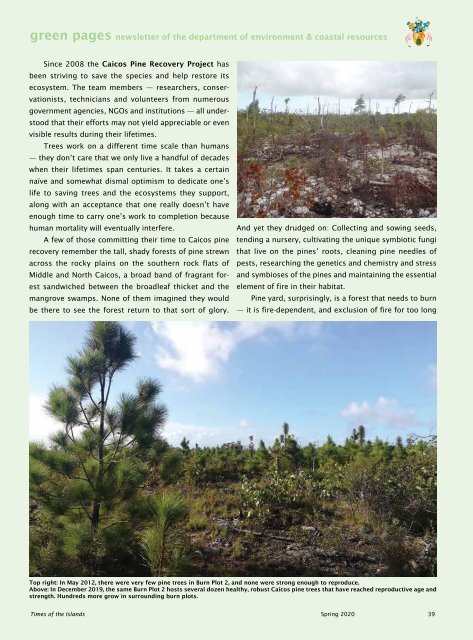Times of the Islands Spring 2020
Presents the "soul of the Turks & Caicos Islands" with in-depth features about local people, culture, history, environment, businesses, resorts, restaurants and activities.
Presents the "soul of the Turks & Caicos Islands" with in-depth features about local people, culture, history, environment, businesses, resorts, restaurants and activities.
Create successful ePaper yourself
Turn your PDF publications into a flip-book with our unique Google optimized e-Paper software.
green pages newsletter <strong>of</strong> <strong>the</strong> department <strong>of</strong> environment & coastal resources<br />
Since 2008 <strong>the</strong> Caicos Pine Recovery Project has<br />
been striving to save <strong>the</strong> species and help restore its<br />
ecosystem. The team members — researchers, conservationists,<br />
technicians and volunteers from numerous<br />
government agencies, NGOs and institutions — all understood<br />
that <strong>the</strong>ir efforts may not yield appreciable or even<br />
visible results during <strong>the</strong>ir lifetimes.<br />
Trees work on a different time scale than humans<br />
— <strong>the</strong>y don’t care that we only live a handful <strong>of</strong> decades<br />
when <strong>the</strong>ir lifetimes span centuries. It takes a certain<br />
naïve and somewhat dismal optimism to dedicate one’s<br />
life to saving trees and <strong>the</strong> ecosystems <strong>the</strong>y support,<br />
along with an acceptance that one really doesn’t have<br />
enough time to carry one’s work to completion because<br />
human mortality will eventually interfere.<br />
A few <strong>of</strong> those committing <strong>the</strong>ir time to Caicos pine<br />
recovery remember <strong>the</strong> tall, shady forests <strong>of</strong> pine strewn<br />
across <strong>the</strong> rocky plains on <strong>the</strong> sou<strong>the</strong>rn rock flats <strong>of</strong><br />
Middle and North Caicos, a broad band <strong>of</strong> fragrant forest<br />
sandwiched between <strong>the</strong> broadleaf thicket and <strong>the</strong><br />
mangrove swamps. None <strong>of</strong> <strong>the</strong>m imagined <strong>the</strong>y would<br />
be <strong>the</strong>re to see <strong>the</strong> forest return to that sort <strong>of</strong> glory.<br />
And yet <strong>the</strong>y drudged on: Collecting and sowing seeds,<br />
tending a nursery, cultivating <strong>the</strong> unique symbiotic fungi<br />
that live on <strong>the</strong> pines’ roots, cleaning pine needles <strong>of</strong><br />
pests, researching <strong>the</strong> genetics and chemistry and stress<br />
and symbioses <strong>of</strong> <strong>the</strong> pines and maintaining <strong>the</strong> essential<br />
element <strong>of</strong> fire in <strong>the</strong>ir habitat.<br />
Pine yard, surprisingly, is a forest that needs to burn<br />
— it is fire-dependent, and exclusion <strong>of</strong> fire for too long<br />
Top right: In May 2012, <strong>the</strong>re were very few pine trees in Burn Plot 2, and none were strong enough to reproduce.<br />
Above: In December 2019, <strong>the</strong> same Burn Plot 2 hosts several dozen healthy, robust Caicos pine trees that have reached reproductive age and<br />
strength. Hundreds more grow in surrounding burn plots.<br />
<strong>Times</strong> <strong>of</strong> <strong>the</strong> <strong>Islands</strong> <strong>Spring</strong> <strong>2020</strong> 39

















